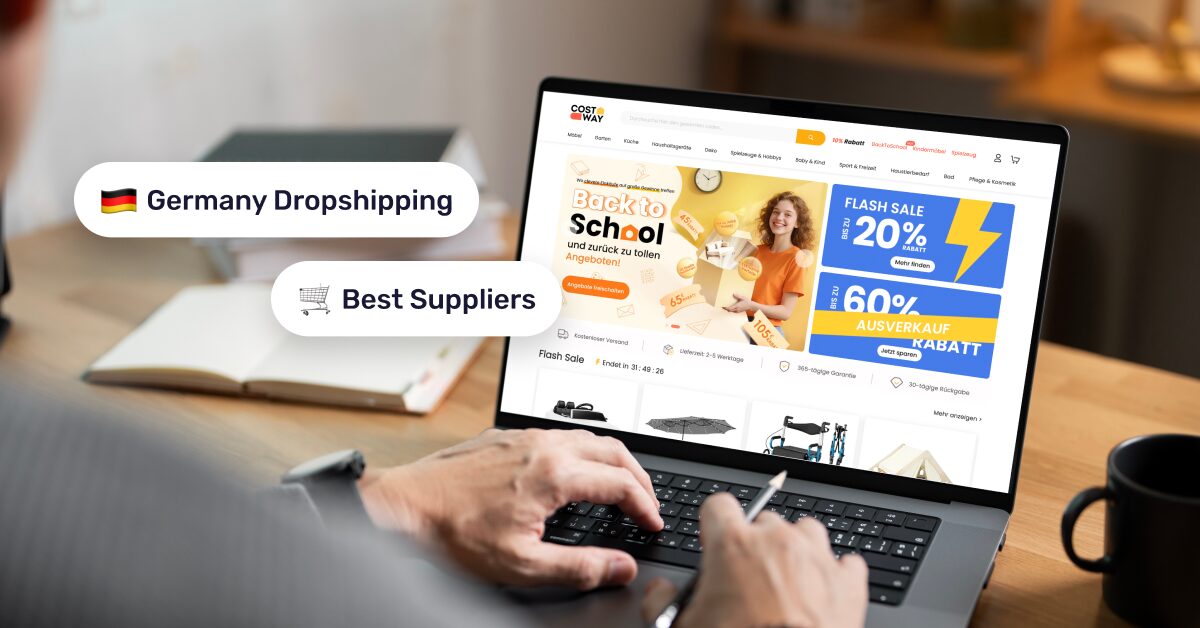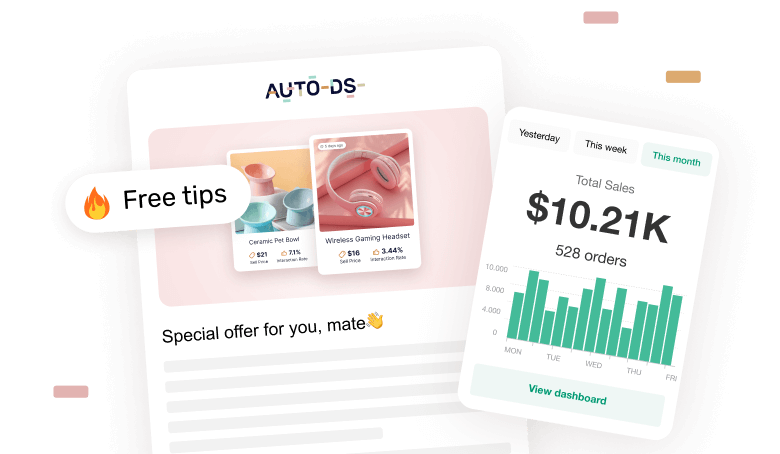Germany is one of Europe’s strongest e-commerce markets. Why? Simple: high buying power, a stable economy, and world-class logistics. This makes it a prime spot for building a profitable dropshipping business.
In this guide, we’ll cover how to start dropshipping in Germany, the key rules to follow, and the best German suppliers. Plus, we’ll show you how automation can make everything easier. For instance, AutoDS helps you find products, connect with local suppliers, and automate the dropshipping workflow so you can focus on selling.
Germany is a top dropshipping market thanks to high e-commerce adoption, strong buying power, and fast EU logistics. According to statistics, it’s one of the biggest e-commerce markets in the world.
Dropshipping in Germany is allowed and totally legal, but compliance matters. Register your business and handle VAT correctly, among other rules, to avoid penalties.
Local suppliers win. Sourcing from German or EU warehouses means faster shipping, fewer returns, and happier customers.
AutoDS simplifies it all with vetted local suppliers, one-click importing, automation, and market data tailored for selling in Germany.
Why Dropshipping in Germany Is a Smart Move
Starting a dropshipping business in Germany? Good idea. Germany is one of Europe’s e-commerce powerhouses. And it keeps growing.
In 2023, total revenue was around $792 million, and is projected to reach $2.77 billion by 2030, with a 19.6% compound annual growth rate. That puts Germany among the highest e-commerce revenues in the world, according to Statista, right behind China, the US, Japan, and the UK.

In fact, according to McKinsey, 80% of surveyed consumers in Germany shopped at an online-only retailer in the previous month. Translation? A huge online customer base.
These shoppers value convenience, but they’re also willing to pay more for products that meet high standards.
Another major plus for Germany? It’s central location in Europe. With excellent logistics services, Germany offers fast, affordable shipping for both domestic areas and other EU countries. This makes it an ideal base if you plan to sell across Europe.
Now, when dropshipping in Germany, keep this in mind: demand is shifting towards niche products, sustainable goods, and locally sourced items. According to a 2025 BCG report, 40% of German consumers regularly consider sustainability when making purchasing decisions.
To match what German shoppers expect, prioritize products that align with these values, highlight eco-friendly features in your listings, and work with local EU-based suppliers to reduce shipping distances.
Want to source items that align with German shoppers’ preferences for quality and fast shipping? AutoDS shows you what’s trending and lets you import it in one click 👉 Start your $1 trial
Is Dropshipping Legal in Germany? Rules & Regulations You Need to Know
Short answer: yes, dropshipping is totally legal in Germany. But, like any business, you need to follow certain rules. Here’s what to know before you start selling.
Registering Your Business
It doesn’t matter if you’re dropshipping as a side hustle or a full-time business. You’ll need to register as a business with your local trade office. This applies whether you’re based in Germany or abroad, targeting German customers.
Value-Added Tax (VAT)
Another major consideration is paying VAT. Germany has a standard VAT rate of 19% (with a reduced 7% for certain goods). You’ll have to register for VAT if…
- …your annual turnover exceeds €25,000 (used to be €22,000 until 2025) for domestic dropshipping. This applies if both the place of shipping and the customer are in Germany, and for small businesses under the Kleinunternehmerregelung (small business scheme).
- …you pass the €10,000 cross-border threshold when the supplier is outside Germany but within the EU.
- …you’re importing goods over €150 from countries outside the EU (like China or the US). For items under that price, you can just use IOSS (Import One-Stop-Shop), an easier system that has been created for low-cost goods.
Once registered, you must include VAT in your prices and issue VAT-compliant invoices.
Consumer Protection And Return Laws
Germany has some of the strictest consumer rights in Europe. As an online seller, you need to:
- Offer 14-day return rights for customers to return items
- Provide clear product descriptions, pricing, and terms of service before purchase
- Issue refunds promptly when returns are made
- Respect GDPR rules for handling customer data
Not following these rules isn’t just bad for customer trust. It can also lead to fines or legal action. That said, once you’ve set up your business and systems properly, staying compliant is pretty straightforward.
Packaging Licensing
Anyone who ships physical products to German customers must register with the LUCID Packaging Register, even if you’re shipping from abroad. This ensures that packaging waste is recycled.
Good news? Under this law, the dropshipper is not actually considered the manufacturer, so they do not need to register or pay licensing fees for shipping. The only obligation for the dropshipper is to make sure all suppliers have a license and comply with this law.
Impressum and Website Legal Pages
In Germany, all business websites must include an Impressum (legal notice) with your name, address, contact info, and business registration number. This applies to both websites and marketplaces like Amazon or eBay. This is a legal requirement, so skipping it can result in a fine.
Also, your website must include:
- A shipping policy page with clear processing times, delivery windows, costs, tracking, and restrictions.
- A cancellation policy with clear terms and steps in German
- A data protection declaration that complies with GDPR
- A cookie consent welcome message (if you use cookies or analytics)
- While this is not legally necessary, you should also include general terms and conditions to prevent issues and clarify everything ahead of time.
Top Dropshipping Suppliers in Germany [2026]

Germany has no shortage of reliable suppliers that ship locally. Here are a few big names worth knowing, all within the list of AutoDS’s vetted suppliers for quality and fast shipping:
- Amazon Germany: it’s Amazon, everyone knows it. Loved by customers for its massive product selection, Prime’s fast shipping, and trusted German brands. Ideal for meeting high delivery and high-quality expectations among shoppers.
- Costway: it’s known for home, garden, and lifestyle products at competitive prices. Often runs discounts and provides EU-based warehouses for quicker shipping.
- Shopify: while not a supplier itself, Shopify’s marketplace connects you to multiple German and EU-based suppliers, making product sourcing easier.
- eBay Germany: this is a mix of direct suppliers and B2B sellers offering both branded and unbranded products. A great place for finding niche items and deals.
- DHGate: A major global supplier platform with a growing number of EU warehouse options, including Germany. Good for sourcing lower-cost products with faster local fulfillment.
📦 Supplier’s Tip: When choosing suppliers, order a few samples before listing products to test quality, packaging, and shipping times. It’s the easiest way to catch issues before your customers do.
AutoDS Suppliers with German Warehouses
Want to start dropshipping in Germany without worrying about slow delivery times? The answer is AutoDS, an all-in-one dropshipping platform that automates the entire process (from sourcing and importing to fulfilling and optimizing) and connects sellers with top suppliers.
With AutoDS Marketplace, you get access to global and private suppliers, including many with local German fulfillment. These private suppliers are exclusive to AutoDS, meaning you won’t find them on every other dropshipping platform. Each supplier is vetted for reliability, product quality, and fulfillment speed. This way, you know you’re sourcing from the best.
With smart filters, you can choose where it ships to and from, along with other fields like price range, currency, and specific supplier. The result? You get the exact items you’re looking for.
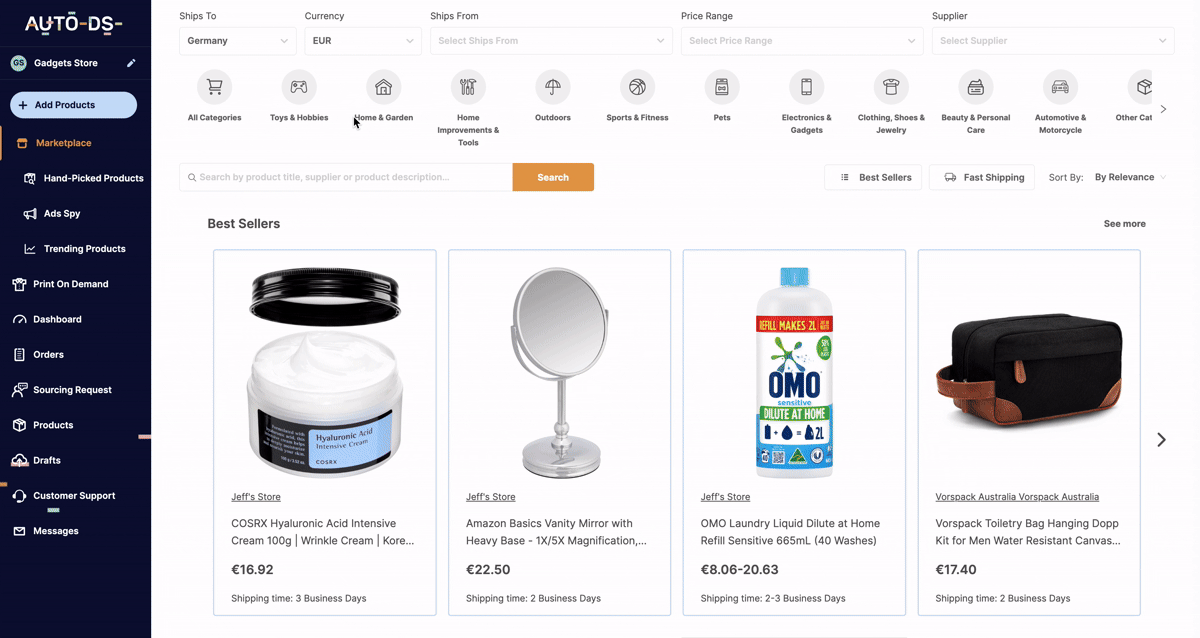
Let’s put it into practice. Say you want to dropship to German customers, from German warehouses, and specifically from Amazon. Once you select your filters, you’ll see a list of hundreds of products that meet those specific requirements.
Bonus? Filter by Best Sellers and/or fast shipping to get only the best of the best. No need to navigate the deep waters of the internet to source items. All in all, you get:
- Fast delivery. No more dealing with “where’s my order” emails.
- Happy customers. Quick fulfillment leads to better reviews and repeat buyers.
- Higher trust. Local shipping makes your store feel more reliable and professional.
How To Start Dropshipping in Germany [Step by Step]
So, you’ve got your business idea, your legal information, and your suppliers. Now, it’s time to actually get started. Here’s a step-by-step guide to start dropshipping in Germany.
Beginner’s Tip:Want to know how much does it cost to start a dropshipping business in 2026? Find out here!
Step 1: Choose A Niche Relevant To The German Market
You know you’re selling products. But what are you selling, exactly? And who are you selling to? Dropshipping is about finding items that are high-converting and appealing to maximize profits. And the truth is, every market is different. It’s not the same to dropship in the US, the UK, or Germany.
So, let’s start by choosing and understanding your niche. Look for products that align with local tastes. Stats indicate that German shoppers lean into quality and sustainability, so that’s a path worth taking.
Also, think of popular categories like home, fitness, tech accessories, or eco-friendly products. Good news? All of these are some of the best dropshipping niches in 2026, so you’re off to a good start.
🔍Research Tip: Use tools like the AutoDS Hand-picked products catalog to search across niches, analyze real-time market data, and validate before committing.
Step 2: Select A Selling Channel
You know what you’re selling and who you’re targeting. Next step? To choose where you’re selling. Are you thinking of creating your own website? Or prefer dropshipping in places like Amazon? Either way, both are good ideas. But you should understand their differences before you make a choice.
There are two types of selling channels:
- Marketplaces, such as Amazon, eBay, AliExpress, and Etsy. These are already popular sites where users are ready to shop, so you don’t have to actually bring the traffic to your store (the traffic is already there). As long as you optimize your listings, they will be able to find you. The drawback? No customization and lots of competition within the marketplaces.
- Online stores, like Shopify, Wix, or WooCommerce. These give you full control over branding (yay!) but you have to drive the traffic yourself through marketing and SEO.
Step 3: Set Up A Store With Legal Compliance
Each country has its own rules and regulations when it comes to online business. If you’re dropshipping in Germany, make sure your store has:
- Impressum (legal notice)
- GDPR-compliant privacy policy page
- Cookie consent
- A clear return and cancellation policy
And make sure to have them all in German.
Step 4: Register Your Business And Manage VAT
Before you go live with your store, register your business with the local trade office (Gewerbeamt) and handle VAT obligations. If you’re selling from outside Germany, use the OSS (One Stop Shop) for EU VAT reporting.
🆕Beginner’s Tip: When handling all things taxes and making sure you’re complying with local regulations, it’s always a good idea to talk to an expert—especially when dropshipping abroad.
Step 5: Import Products Using AutoDS
The fun part! Now it’s time to actually fill your store with items you want to dropship. There are different methods to do this.
The first one is the old manual way. You choose an item you like from a supplier, create a new listing on your store, and start copying and pasting every single detail, from the title to the description, the categories, and the variations. Add to that manually uploading photos and videos. Just… time-consuming.

Then there are the automated methods. With AutoDS, you get importing tools that only take a few clicks. You can source products in the AutoDS marketplace and import them with the one-click importer.
Or you can use the product importer to add items from supported suppliers by just copying and pasting the URL onto the AutoDS platform. The best part? You can import a single product or multiple items from different suppliers at once.
Step 6: Optimize Listings For the German Audience

Now, let’s spice up those listings and optimize them for your new audience: Germans!
First, make sure they are SEO-friendly and polished. Is the title appealing? Does the description cover everything about the product? Does it include shipping and return details? And are the pictures clear and of good quality?
All in all, make sure your listings are professional, clearly structured, and optimized for traffic and conversion. Then, translate everything into natural German. And remember: highlight quality and sustainability to approach this audience, it’s what they value most.
💡 Pro Tip: All of this sounds like too much work? No worries. You can use AutoDS’s AI title and description generator to optimize and localize your listings in just a few clicks. No creative copywriting or German skills needed!
Step 7: Enable Automation
Last step before you go live: customizing your automation settings. If you’re using AutoDS, you’ll have lots of tools at your fingertips to let everything run on its own without constant check-ins. Think of it as switching your store to autopilot, so you can focus on scaling and strategy. Let’s see the two most important ones.
First, the Automatic Price Optimization tool to set automated pricing rules. This adjusts margins based on cost changes and performance to keep prices competitive. You choose rules, and then the system follows.
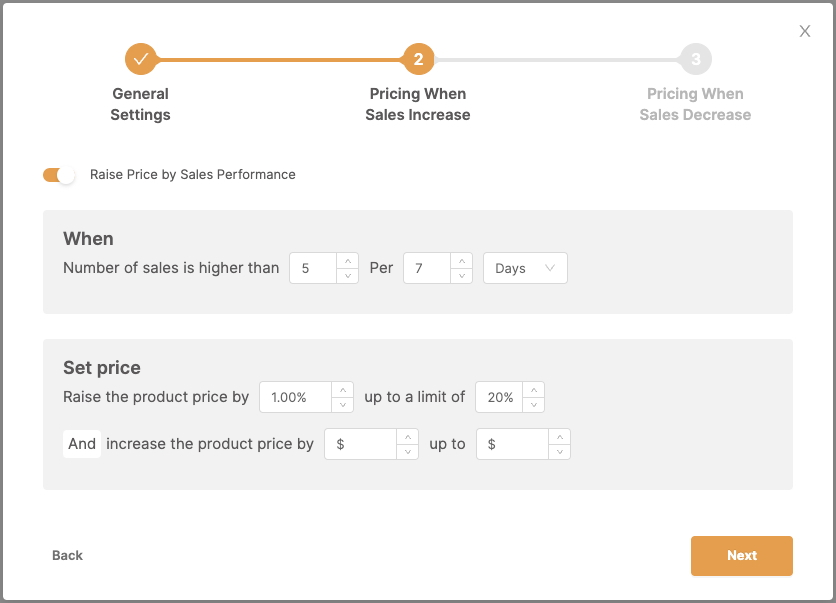
Second, the Price & Stock Monitoring tool. No more selling out-of-stock items or losing profits because a supplier suddenly changes their prices without you noticing. With this tool, the system checks everything for you every 60 minutes to keep your store updated and profitable.
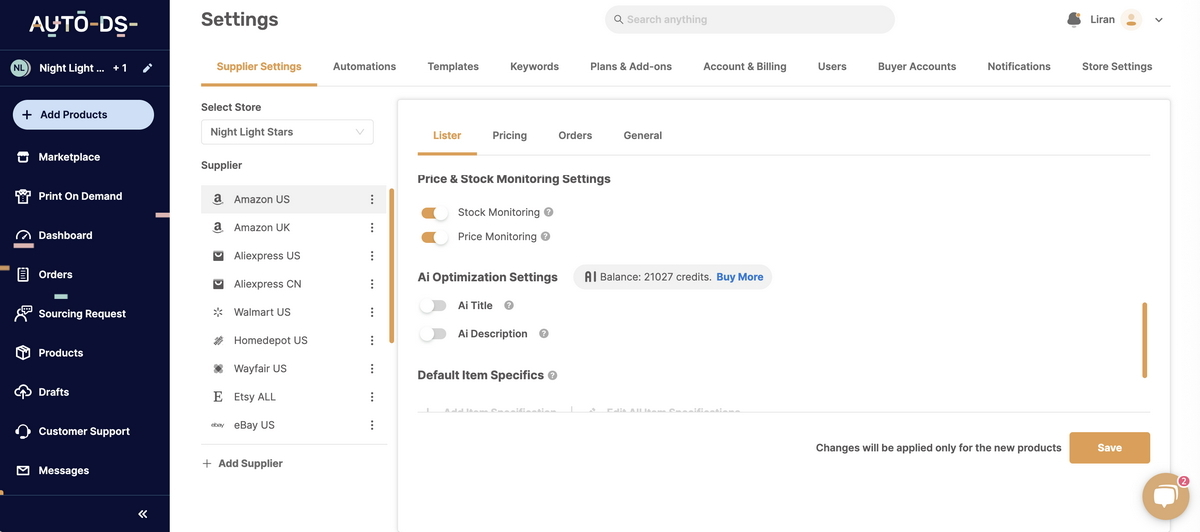
Step 8: Launch Your Store
Once your listings are ready and compliance is in place, publish your products and double-check everything works on both desktop and mobile.
🆕 Beginner’s Tip: Place a test order yourself to make sure the checkout process, payment methods, and email confirmations work just fine.
Step 9: Execute Marketing Campaigns
To actually drive traffic and sales to your store, you will need to do some marketing. There are different things you can do:
- Start with organic campaigns. Create an Instagram, TikTok, Facebook, and Pinterest account to showcase your products. Lean on visual, fun videos to increase reach.
- Look for influencer collabs to promote your products in authentic content, reach their audience, and build trust faster.
- Rely on localized SEO targeting German keywords to rank higher in local search results, attract organic traffic, and connect with shoppers using the exact phrases they search for.
- Create email lists to build a direct line to your customers, send product updates, share special offers, and encourage repeat purchases.
- Consider paid ads on Google and Meta to drive targeted traffic and reach customers who are ready to buy.
Step 10: Monitor Performance And Optimize
The process doesn’t finish once everything is live. Dropshipping is a continuous flow of analyzing and optimizing metrics to continue improving. Track sales, traffic, and conversion rates. Adjust pricing, swap out low-performing products, and double down on winning items. AutoDS analytics can help you spot what’s working (and what isn’t).
How AutoDS Helps You Dropship in Germany (and Win)
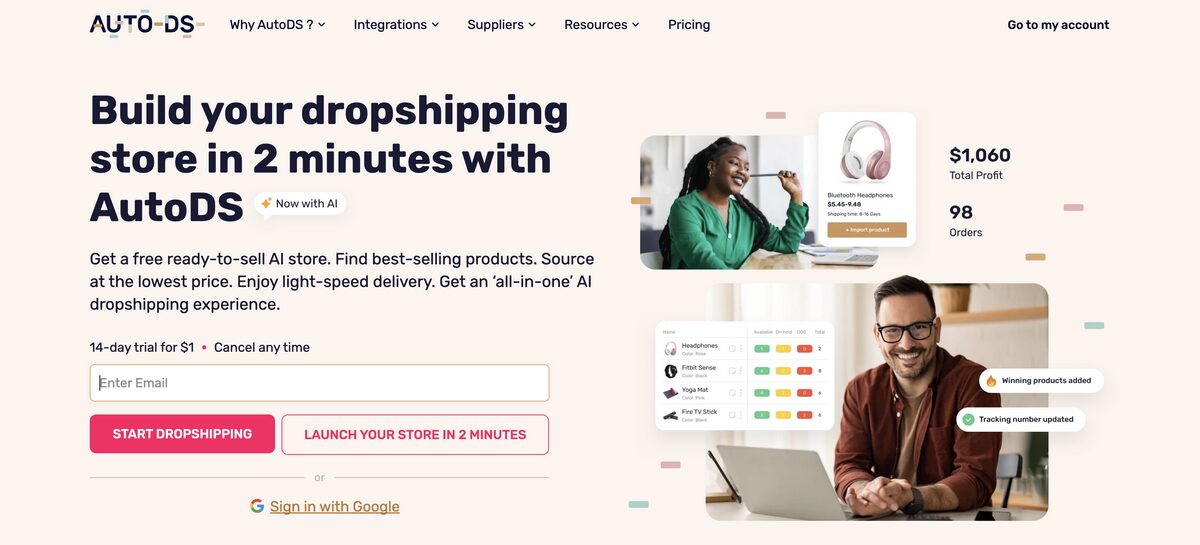
Selling in Germany is one thing. Selling well in Germany is another. This means happy customers, fast deliveries, smooth operations, no complaints, you name it. But don’t panic. With AutoDS, you get the tools, the suppliers, and the automation to make it all happen without drowning in manual work and copy-pasting. Let’s see:
- Local supplier access. Easily find suppliers that ship from Germany or nearby EU hubs right inside the AutoDS Marketplace. Many offer German warehouse fulfillment, which means faster delivery, fewer returns, and higher customer trust.
- One-click product importing. Import product listings directly into your store in seconds. You can even start with German-language listings and translate them easily before publishing.
- Full store automation. From order fulfillment to tracking updates, AutoDS handles manual tasks for you. It creates stores in minutes, monitors stock and prices from suppliers, follows pricing rules as you wish, optimizes listings, and more. The result? Manual tasks that usually take hours are simplified into just a few clicks.
- Advanced product research tools. Use the trending product finder with Germany-specific filters to spot what’s hot right now, especially in the location you’re interested in. No guesswork, just real-time data.
- Multilingual support and training. AutoDS offers onboarding and support in German, making it easier for local sellers or international dropshippers targeting Germany.
Bottom line: With AutoDS, you’re not just listing products in Germany. You’re building a store that pretty much runs on its own, backed by real data and automation.
Frequently Asked Questions
Is dropshipping allowed in Germany?
Yes, dropshipping is absolutely allowed in Germany, as long as you comply with local business registration requirements, VAT rules, consumer protection laws, and other e-commerce regulations like packaging and data privacy.
Do I need a company or VAT number to start dropshipping in Germany?
The short answer is yes. If you’re dropshipping in Germany, you do need to register a business. And, once you pass the turnover threshold (€22,000 for domestic sellers or €10,000 cross-border), register for VAT. Even if you’re based outside of Germany, VAT rules apply when selling to German customers.
What are the best dropshipping suppliers in Germany?
Some top supplier options for dropshipping in Germany include Amazon, eBay, and Costway, as they have German-based warehouses. You can also find private suppliers with German fulfillment through the AutoDS Marketplace, all vetted for quality, performance, and fast shipping.
Can I use AliExpress to dropship in Germany?
Yes, you can use AliExpress to dropship in Germany. But be aware that many AliExpress suppliers ship from outside the EU, which means longer delivery times and potential customs fees. To avoid these issues, look for AliExpress sellers with EU or German warehouses.
How does AutoDS support dropshipping to Germany?
AutoDS supports dropshipping to Germany by connecting you to suppliers with German and EU warehouses. It also offers one-click importing, automates orders and tracking, syncs inventory and prices in real time, and provides advanced product research tools with Germany-specific filters. It also offers German onboarding, so you can get started quickly.
Conclusion: Ready To Start Dropshipping in Germany?
Germany offers one of the most profitable and reliable markets for dropshipping in Europe. With high online shopping penetration, strong buying power, and high-end logistics, it’s dropshipping heaven for sellers.
Success here comes down to two things. First, staying compliant with local laws, like business registration, VAT, and consumer protection. Second, choosing suppliers who can deliver the quality and speed that German shoppers expect. That means prioritizing local or EU-based fulfillment.
The faster path to success? Dropshipping platforms. AutoDS helps you access vetted suppliers with German warehouses, automate orders, find high-converting items, and more. This makes dropshipping faster, easier, and more profitable.
Ready to start dropshipping in Germany the smart way? 👉Get started with AutoDS for just $1 and turn Europe’s strongest e-commerce market into your favorite customer base.
Here are a few more articles you might find interesting:






